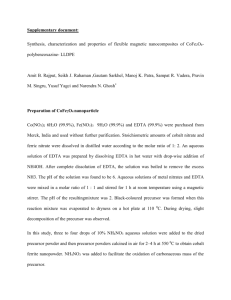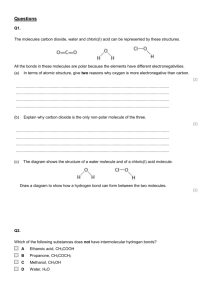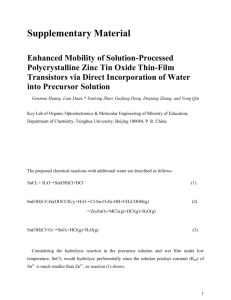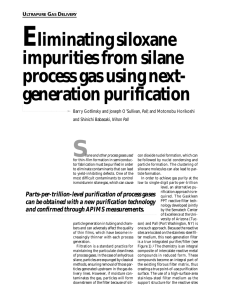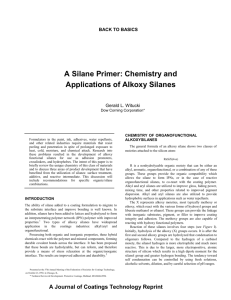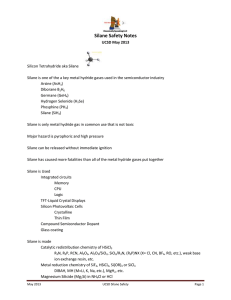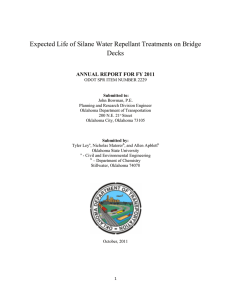POLA_23972_sm_suppinfo
advertisement
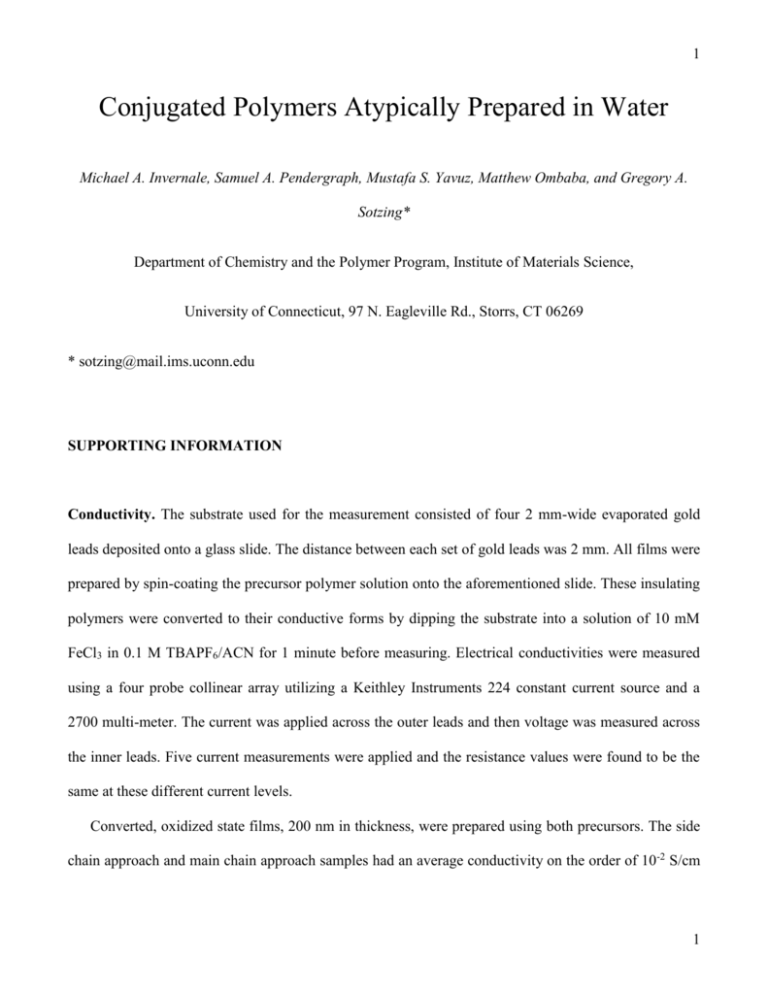
1 Conjugated Polymers Atypically Prepared in Water Michael A. Invernale, Samuel A. Pendergraph, Mustafa S. Yavuz, Matthew Ombaba, and Gregory A. Sotzing* Department of Chemistry and the Polymer Program, Institute of Materials Science, University of Connecticut, 97 N. Eagleville Rd., Storrs, CT 06269 * sotzing@mail.ims.uconn.edu SUPPORTING INFORMATION Conductivity. The substrate used for the measurement consisted of four 2 mm-wide evaporated gold leads deposited onto a glass slide. The distance between each set of gold leads was 2 mm. All films were prepared by spin-coating the precursor polymer solution onto the aforementioned slide. These insulating polymers were converted to their conductive forms by dipping the substrate into a solution of 10 mM FeCl3 in 0.1 M TBAPF6/ACN for 1 minute before measuring. Electrical conductivities were measured using a four probe collinear array utilizing a Keithley Instruments 224 constant current source and a 2700 multi-meter. The current was applied across the outer leads and then voltage was measured across the inner leads. Five current measurements were applied and the resistance values were found to be the same at these different current levels. Converted, oxidized state films, 200 nm in thickness, were prepared using both precursors. The side chain approach and main chain approach samples had an average conductivity on the order of 10-2 S/cm 1 2 and 0.78 S/cm, respectively. The higher value for the converted main chain precursor indicates a longer conjugation length for the silane system and better π-overlap for interchain charge hopping. It was expected that a linear, main chain precursor (which converts via electrodesilylation and coupling of the aromatic units) would have a higher conductivity than a crosslinked pendant network (which converts under a restricted environment due to limitations imposed by the backbone). The conjugation and interchain interactions of the former system lend themselves to higher conductivities than those of the crosslinked network. EQCM, EDX, and Elemental Analysis for Conversions of Poly(6). Elemental Analysis was performed by Galbraith Laboratories. EDX data was collected using an AMRAY 1810 SEM and IXRF Systems Inc 500 Digital Processing. EQCM was performed using a CHI400 potentiostat. EDX analysis of the elemental composition of organic-converted films of the silane precursor was carried out. The ratio of Sulfur to Silicon in the precursor film was 2.47 (theoretically 3:1 from monomer structure); this ratio increases to 7.09 after conversion. In order to better characterize the aforementioned conversion to conducting polymer, particularly the cleavage of silane moieties from the backbone during aqueous processing, the use of electrochemical quartz crystal microbalance (EQCM) was employed. Both organic and aqueous conversions have been observed to show mass loss upon conversion corresponding to a clearly defined increase in the vibrational frequency of the quartz crystal in use. The masses were calculated using the Sauerbrey Equation, Δf = -2 (f02) (Δm) / [A*√(q q)] where f0 is the fundamental frequency, m is mass, A is the electrode area, q is the Shear Modulus of quartz, and q is the density of quartz. These constants are summarized in Supporting Table 1, along 2 3 with some parameters used for the EQCM experiments. The calculated mass percent of the silane group per monomer unit is 41%, which serves as the upper limit for percent mass loss. Fundamental Shear modulus Density Area scan rate Voltage Frequency (Hz) (g/cm*s2) quartz (g/cm3) (cm2) (mV/s) Range 7,995,000 2.947 x 1011 2.648 4.099 25 0–1 Supporting Table 1. Constants for the Sauerbrey Equation and Parameters for EQCM for Poly(6). The calculated total percent mass loss of a film undergoing conversion to conducting polymer in brine was 23%. The baseline was taken at +0.1 V, where the curve was the flattest and subsequent scans showed a clear and regular frequency increase, indicating mass loss. The differences in frequency, along with the initial mass of the film calculated from the fundamental frequency, were used to calculate the mass lost per cycle. It is clear that mass is leaving the film upon oxidation. Even if one were to extrapolate the masses for the next two unmeasured cycles, the mass does not exceed the upper limit of percent loss. Also, some mass loss will be masked by the counter ions which enter the film as charge compensators during the electrochemical processes. A small percentage of these anions then become trapped in the film upon the return to the neutral state. However, together with other experiments, EQCM confirms once again that mass is leaving the film and that the soluble precursor copolymer has been converted to the insoluble, conducting product. The film could not be washed off the EQCM crystal after the experiment was complete. Approximately 23% mass loss out of a possible 41% loss is also consistent with the reported loss of silane moieties shown by elemental analysis (23% out of 41% is approximately 56% of the silane moieties). 3 4 Monomer Percentage Percentage (Theoretical Percentage Portion (Original) Max – Post-Conversion) (Galbraith) Full 100% 100% - Organic 59% 100% - Silane 41% 0% - Carbon 62.34% 53.04% 46.8% Hydrogen 7.14% 2.76% 3.69% Nitrogen 0% 0% <0.5% Sulfur 15.58% 26.52% 19.47% Oxygen 10.44% 17.68% - Silicon 4.5% 0% 1.80% Supporting Table 2. Elemental Analysis of Organic-converted Silane Precursor. Cyclic Voltammetry. Plots of the CVs taken for the six systems studies appear below. Electrodeposition, organic conversion, and aqueous conversion for main and side-chain precursors are included. 4 5 Supporting Figure 1. Cyclic voltammograms for the conversion of the norbornene precursor poly(4) and via (A) organic conversion (solid line is first cycle), (B) electrodeposition, and (C) aqueous conversion (red scan is first cycle). Voltages reported vs. an organic Ag/Ag+ reference electrode calibrated to be 0.4385 V vs. NHE (a and b) and against a Ag/AgCl in 3 M NaCl, 0.230 V vs. NHE (c). Supporting Figure 2. Cyclic voltammograms for the conversion of the silane precursor poly(6) via (A) organic conversion (solid line is first cycle), (B) electrodeposition, and (C) aqueous conversion (red scan is first cycle). Voltages reported vs. an organic Ag/Ag+ reference electrode calibrated to be 0.4385 V vs. NHE (a and b) and against a Ag/AgCl in 3 M NaCl, 0.230 V vs. NHE (c). 5 6 Supporting Figure 3. SEM image of a side-chain crosslinked converted precursor, showing the rougher morphology than the main-chain converted system (Figure 3 in main text). 6
